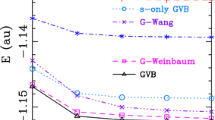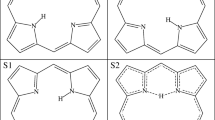Abstract
Based on the correspondence of the molecular orbital theory and valence bond theory to the description of chemical bonds, theab initio valence bond (VB) calculations of the low-lying states of diatomic molecules are realized. The calculation results for the low-lying states of B2 show that the VB calculation has clear-cut physical significance, and its simulation of the behavior of the potential energy surface about the equilibrium position is superior to that of the molecular orbital theory. The valence bond calculation involving only a few bonded tableaus can correctly reflect the effect of electronic correlation.
Similar content being viewed by others
References
Gerratt, J., Orville-Thomas, W. J., Advance in valence bond theory,J. Mol. Struct. (Theochem.), 1991, 222: 1.
Cooper, D. L., Gerratt, J., Raimondi, M., Application of spin-coupled valence bond theory,Chem. Rev., 1991, 91: 929.
McWeeny, R., Ionization and attachment in valence bond theory,Chemical Physics, 1996, 204: 463.
Shaik, S., Hiberty, D. C., Valence bond mixing and curve crossing diagrams in chemical reactivity and bonding,Advances in Quantum Chemistry, 1995, 26: 99.
McWeeny, R., Valence bond theory: Progress and prospects,Int. J. Quantum Chem. Quantum Chem. Sym., 1990, 24: 733.
Wu, W., McWeeny, R., Valence bond calculations of the potential energy surface for CH4→CH3+H,J. Chem. Phys., 1994, 101: 4826.
Li, X., Zhang, Q., Bond tableau unitary group approach to the many-electron correlation problem,Int. J. Quantum Chem., 1989, 36: 599.
Wu Wei, A study of valence bond method in quantum chemistry,Doctorate Thesis (in Chinese), Xiamen University, Xiamen, 1989.
Li, J., Wu, W., New algorithm for nonorthogonalab initio valence-bond calculation,Theor. Chim. Acta, 1994, 89: 105.
Wheland, G. W.,Resonance in Organic Chemistry, New York: John Wiley, 1995.
Huber, K. P., Herzberg, G.,Molecular Spectra and Molecular Structure IV, New York: Van Nostrand Reinhold Company, 1979.
Langhoff, S. R., Bauschlicher, C. W. Jr., Theoretical study of the spectroscopy of B2,J. Chem. Phys., 1991, 95: 5882.
Author information
Authors and Affiliations
Additional information
Project supported by the National Natural Science Foundation of China
Rights and permissions
About this article
Cite this article
Cao, Z., Wu, W. & Zhang, Q. Valence bond study on excited states of molecules. Sc. China Ser. B-Chem. 40, 548–553 (1997). https://doi.org/10.1007/BF02875426
Received:
Issue Date:
DOI: https://doi.org/10.1007/BF02875426




